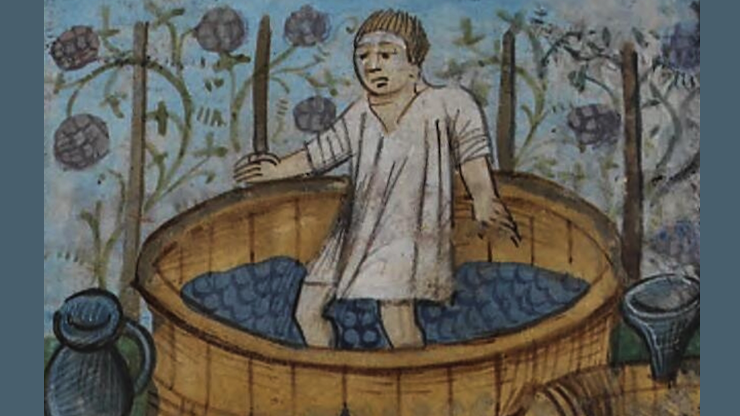In this ongoing series, we ask SF/F authors to describe a specialty in their lives that has nothing (or very little) to do with writing. Join us as we discover what draws authors to their various hobbies, how they fit into their daily lives, and how and they inform the author’s literary identity!
Like most writers, I take my drinking seriously. So seriously, in fact, that in recent years I started learning how to make my own booze. Y’know … just in case the apocalypse happened and someone needed to know how to perform this valuable social service.
It all started with my inner circle of friends. Several years ago they invited my wife Kara and I to join their wine-tasting group. We all met a few times a year to educate ourselves about wine in all of its wonderful forms and varieties, and to learn how to pair different wines with foods. We learned the basics of wine very quickly: sulfites, tannins, acidity, and a bunch of other nerdy wine terms became fixtures in our new vocabulary.
Those gatherings sometimes were “horizontal” tastings, in which several different wines of the same varietal (e.g., Cabernet Sauvignon, Zinfandel, or Riesling, etc.) from the same year (aka vintage) would be compared. This was a great way to learn about the effects that terroir (a complex interplay of each wine’s local microclimate, soil, etc.), variations in the winemaking process from one vintner to another, and other factors had on the finished product.
Other gatherings were “vertical” tastings, in which several bottles of the same varietal from the same vintner, but from different years, are compared. This was useful to understanding how each year’s specific weather affects the grapes and the wine they produce.
Then we began having regional tastings, in which we explored the varietals associated with a country or sometimes even a specific growing region, such as Tuscany, Italy; the Russian River Valley in California; or the North Fork of Long Island, NY. My wife and I started hosting wine nights during this phase; we studied, prepared booklets, and planned pairing menus for a night of wines from South America, and another for those of Greece.
About six years ago one of the group’s ringleaders proposed a new adventure: making our own wine. We learned that there were several businesses in our area that specialized in procuring grapes from premium growing areas, and that provided winemaking equipment and facilities. Intrigued, we formed a winemaking group, shared the startup costs, and got to work.
The process begins in October with the “crush.” The grapes are separated from the stems by a machine that resembles an enormous drill bit inside a steel trough. Whole bunches of grapes go into it; mangled grapes and juice—the “must”—come out and are pumped into a sterilized plastic basin. Sulfites are added to kill off “bad” yeasts, and then a blend of “good” winemaking yeasts are mixed with warm water and blended into the must, which is then covered for a week.
The following week brings the “press.” The fermenting grapes are scooped from the bin and put into a hydraulic press. This fearsome beast of a machine squeezes out every last drop of recoverable juice, which is pumped through a filter into a steel canister. There the juice will rest for a few days, allowing sediment to settle to the bottom, before it is transferred into an oak cask for aging. Before this, however, the cask must be prepared: it is rinsed to get rid of loose bits of char clinging to the insides of the staves. Once it runs clean, the interior of the cask is primed with a wash of diluted citric acid. Then, in goes the wine!
And there it sits, “racked,” for several months. We usually paid our wine a visit in the middle of winter for a barrel tasting, to see how our wine was maturing, and to make sure it wasn’t becoming overly tannic ahead of schedule. Most years, our experiments are ready for bottling by June. We have gotten good at running the bottline production line. My job lies at the end of that line: I am the anal-retentive OCD person the group trusts to affix the labels on the bottles.
I’ve also indulged my artistic side as the group’s designer. Most of the time it’s a group effort to name the wines, but I’m the one who creates the labels. It helps that most of our wines have had pun-tastic names: The Twilight Rhône, Born to Rhône, Invader Zin, and Que Sera Syrah have been my favorites so far (both to design and to drink).
We’ve been lucky so far and have made some delicious wine. Our process doesn’t make a lot of it, however. Each year Kara and I are lucky to take home two cases, and they never seem to last as long as we wish they would.
I guess that means we’ll just have to go make some more wine.
 David Mack is the New York Times bestselling author of over 30 novels of science fiction, fantasy, and adventure. His new novel The Midnight Front is a World War II fantasy epic packed with demon-plagued magicians who drink almost as much as he does, and it’s available now from Tor Books.
David Mack is the New York Times bestselling author of over 30 novels of science fiction, fantasy, and adventure. His new novel The Midnight Front is a World War II fantasy epic packed with demon-plagued magicians who drink almost as much as he does, and it’s available now from Tor Books.










